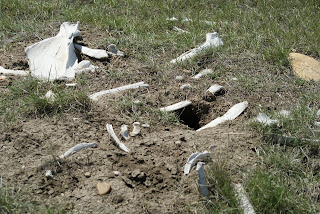
Someone asked me to explain rope dragging, so here goes. It is a method developed awhile back to help researchers find nests in a large area. It can only be done in open areas like prairies. The process involves dragging a 20-meter long rope (weighted down with rock-filled cans) back and forth across the ground. The sound of the cans, as well as the rope passing by overhead, scares a bird into flushing from its nest. The grass is thick enough that the rope passes through without harming the nest or eggs. It simply causes the bird to flush, allowing us to see where the general area of the nest is. Even so, most nests are ridiculously difficult to find. They have to be, in order to prevent them being found easily by predators, like this Richardson's ground squirrel.

The area around here has a rich history, from early First Nations people, to homesteaders struggling to scrape a living from the harsh prairie sod. Evidence of their passing can be seen from time to time.

Besides the decades- and sometimes centuries-old signs of human habitation, there are often bones left behind by animals (mainly cows and deer) that lived and died here. Sometimes these remains resemble a sort of graveyard, with the only signs of life being the teeth-marks left by coyotes.

Some of the flowers have also begun to bloom. The nice thing out here is that each flower blooms at a different time during the summer, meaning that each week there is a different brush of color against the brownish-green background.


The migrant sparrows at our feeder all seem to have left for the next stage of their long journey. The grackles and cowbirds have still been gorging, though. Likely they'll continue to be daily visitors for the remainder of the summer. Yesterday a Vesper Sparrow stopped by. They breed here in the prairies, and are one of my study species. Out here, they are distinguished from the other 7 or so sparrow species by the dark cheek with a lower white border.
I was also asked to define what a life bird (or lifer) is. It is a term used by birders to recognize a species they have never seen before. Typically the "rules" are that it has to be wild, alive, and unrestrained to be counted. Many birders keep life lists, to keep track of how many species they have seen. Many different types of lists can be kept, including North American, country, state/province, county, town, or even backyard lists. Year lists are common as well. Typically I only keep a life and North American list, though since coming to Canada I've also kept Manitoba and Saskatchewan lists. My life list currently stands at 441, while my Saskatchewan list is 108 (over 30 of which were lifers!).
Tomorrow my crew will go out and drag another plot. The nests we are hoping to find belong to these species: Baird's Sparrow, Savannah Sparrow, Vesper Sparrow, Chestnut-collared Longspur, McCown's Longspur, and Sprague's Pipit.


How did you get that ground squirrel shot? It's fantastic. Anyways, I'm still really enjoying your blog. My life list is up to 520 now, but it sounds like you're cathing up. I'm still jealous of the Merlins you mentioned. ;)
ReplyDelete